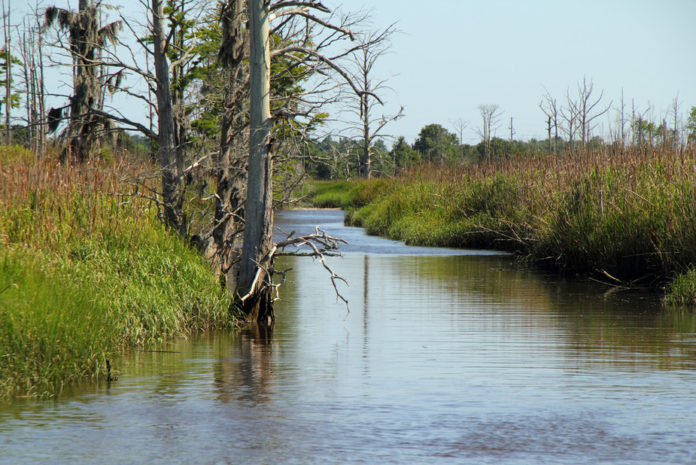
Adell Amos, University of Oregon
Last week, the Environmental Protection Agency and the Army Corps of Engineers released the long-anticipated Clean Water Rule. The new rule aims to clarify years of confusion about which waters – including certain tributaries, marshes and wetlands – fall within the definition of “waters of the United States” and are protected under the Clean Water Act (CWA).
The Supreme Court has always recognized that the CWA extends beyond navigable rivers and lakes to wetlands, marshes and other connected waterways.
Beginning in 2001, however, several decisions from the Supreme Court raised uncertainty about how far that jurisdiction reaches. The legal question has been where to draw the line of connectivity in the ecosystem when considering the impact on water quality downstream.
As a result of the confusion, government agencies, private landowners and others have engaged in a laborious and time-consuming, case-by-case analysis. A body of water that has a significant nexus, a phrase coined by Justice Anthony Kennedy, to a “jurisdictional” waterway (or one covered by the law) determines whether the CWA applies. The new rule seeks to be more specific on which waters are subject to the CWA.
Despite bitter public opposition from industries including homebuilders, energy developers and agriculture, the clarity and certainty provided by the rule presents a welcome change from the time-consuming individualized determinations that characterized the last decade. From the conservation perspective, the new rule protects clean water, reduces pollution and addresses upstream impacts on downstream vulnerable waterways.
Rule-making process and the rule
The nearly 300-page rule results from extensive public engagement, including over one million public comments and more than 400 meetings with stakeholders around the country.
The process included a comprehensive review of all relevant literature, including over 1,200 peer-reviewed publications focused on the influence of upstream water quality on downstream water conditions. The EPA compiled this information in a draft report, sought additional peer review from the independent Science Advisory Board and released the findings in January of 2015.
The Science Report concluded, among other things, that the scientific literature demonstrates that tributary streams, regardless of their size or frequency of flow, as well as wetlands, are connected to downstream waters and influence their integrity and function.

Chesapeake Bay Program, CC BY-NC
The new rule can be thought of as dividing waters into three categories – in, subject to analysis, and out.
Waters that are in are not subject to any additional analysis of whether the CWA applies. This category includes water that can float a boat, coastal waters, interstate waters, water impounded behind dams, flowing rivers and lakes. The rule leaves unchanged the longstanding protections for waters that have always been considered jurisdictional.
Tributary water is defined as those waters with an ordinary high water mark and a bed and a bank, but not requiring the water to be navigable or flow year-round. In the past, tributary water was often evaluated on case-by-case basis to determine its significance to a downstream waterway. Under the new rule, tributary water is automatically within the reach of the CWA’s protections.
Adjacent waters include wetlands, ponds, oxbows and other waters that are adjacent to other covered waters. The rule defines these adjacent waters as any water body within the mapped 100-year floodplain. If waters are within 100 feet of the ordinary high water mark of covered water – or within the 100-year floodplain and within 1,500 feet of the ordinary high water mark of covered waters – then they are considered jurisdictional and are covered. The new rule draws these geographic lines, for the first time in the law’s 40-year history, and provides a level of bright-line clarity that has not been included before now.

The second category of waters includes those that are subject to a case-by-case analysis. For these waters, the agencies will analyze the relationship to downstream waters by looking at whether actions have a significant effect on, or significant nexus to, conditions downstream. This category includes bodies of water that the rule sets out as deserving special consideration, including prairie potholes, Carolina and Delmarva bays, pocosins, western vernal pools in California, and Texas coastal prairie wetlands. This category also includes adjacent waters that are within the 100 year floodplain and within 4,000 feet of the ordinary high water mark of covered water. In conducting the case-by-case analysis under the new rule, the agencies are to consider not each feature individually, but the system in which they are a part in making the significant nexus conclusion.
The third category describes those waters that are excluded – or out of the reach of the CWA. The new rule retained all existing exclusions as well as adding some new categories. Those waters that are out include wetlands drained before a certain date, treatment ponds and lagoons, ditches, stormwater control features, water-delivery systems, artificial ponds used for livestock watering, groundwater and man-made channels, among others. In addition, this category also includes non-adjacent wetlands – those falling outside the 100-year floodplain and beyond 4,000 feet of jurisdictional water. These exclusions extend further than the previous rule.

Chesapeake Bay Program, CC BY-NC
As has always been the case, states and federally recognized tribes maintain their authority to implement their own programs to enact rules that are more protective than the standards provided at the federal level.
In all, the new rule expands the types of water that can be considered automatically protected by 3%, as estimated by the EPA.
Detailed case-by-case analysis is limited to categories of water listed for special consideration (seasonal wetlands, such as prairie potholes and vernal pools, as well as similar features) and waters that are outside the 100-year floodplain or within 4,000 feet from a jurisdictional waterway.
The new rule also contains a broader set of specific exemptions, including many for water features that were the most worrisome to critics of the proposed rule, such as many agricultural ditches.
The road ahead
Many in the conservation community are disappointed that the list of excluded waters has expanded, that geographical boundaries have been used for the first time in the history of the CWA to delineate jurisdiction, and that isolated wetlands, like the vernal pools, are not automatically covered.
Already some organizations are noting that the rule does not go as far as the underlying science would support.
On the other side of the fence, many of the people subject to regulation bristle at the expanded definition of tributary water and in general will accuse the agencies of jurisdictional overreach. Yet the intent of the rule is to provide the kind of consistency and clarity that has been sorely needed and often called for by those in the regulated community.
A bill in the House to block release of the final rule has already passed, and similar legislation has been introduced in the Senate. The White House has threatened veto. The rule will also face legal challenges on the rule-making process itself and the reach of the CWA.
Unless we are prepared to return to the uncertain regulatory landscape of the last decade or to dramatically change our shared commitment to clean water as embodied in the 40-year history of the CWA, these efforts to challenge the new rule seem more partisan and political than substantive. Either way, we are far from finished with this debate.
When the CWA was adopted in 1972, public sentiment supported clean healthy waterways. Perhaps that’s because the Cuyahoga River in Ohio was known to catch fire, raw sewage was regularly released into waterways like the Mississippi River and over two-thirds of the nation’s waterways were not safe for swimming.
Although rivers are no longer catching fire, clean, healthy water still needs protection. The Clean Water Rule offers a measured, predictable approach to addressing our shared commitment to clean water, recognizing the scientific reality that what happens upstream impacts all of us downstream.
![]()
Adell Amos is Associate Dean for Academic Affairs, Associate Professor of Environmental and Natural Resources Law at University of Oregon.
This article was originally published on The Conversation.
Read the original article.




















